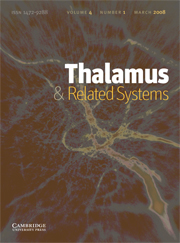Article contents
Circuits through prefrontal cortex, basal ganglia, and ventral anterior nucleus map pathways beyond motor control
Published online by Cambridge University Press: 18 April 2006
Abstract
The ventral anterior (VA) nucleus of the thalamus is connected with prefrontal and premotor cortices and with the basal ganglia. Although classically associated with motor functions, recent evidence implicates the basal ganglia in cognition and emotion as well. Here, we used two complementary approaches to investigate whether the VA is a key link for pathways underlying cognitive and emotional processes through prefrontal cortices and the basal ganglia. After application of bidirectional tracers in functionally distinct lateral, medial, and orbitofrontal cortices, we found that projection neurons were embedded in much larger patches of axonal terminations found in the magnocellular part of VA (VAmc), and in the principal part of VA. Connections from medial prefrontal cortices occupied the dorsomedial and ventromedial VA, and orbitofrontal connections were found in ventrolateral VAmc. Moreover, about half of all projection neurons in orbitofrontal areas directed to the VA or VAmc were positive for calbindin but not parvalbumin, even though comparable populations of neurons were positive for each marker in the VA. We then applied tracers in VA and investigated simultaneously projections from all prefrontal areas, the internal segment of the globus pallidus (GPi), the substantia nigra reticulata (SNr), and the thalamic reticular nucleus. Projection neurons were most densely distributed in anterior cingulate areas 24 and 32, and dorsolateral areas 9 and 8, innervating the same VA sites that received projections from a large part of GPi and dorsal SNr. Nearly as many projection neurons originated from cortical layer V as from layer VI. There is evidence that cortical layer VI neurons innervate thalamic neurons that project focally to the middle cortical layers, whereas layer V neurons synapse with thalamic neurons projecting widely to cortical layer I. Projections from layer V to the VA may facilitate cortical recruitment for executive functions within a cognitive context through lateral prefrontal areas, and autonomic responses within an emotional context through anterior cingulate areas.
Information
- Type
- Research Article
- Information
- Copyright
- 2004 Elsevier Science Ltd
- 3
- Cited by

